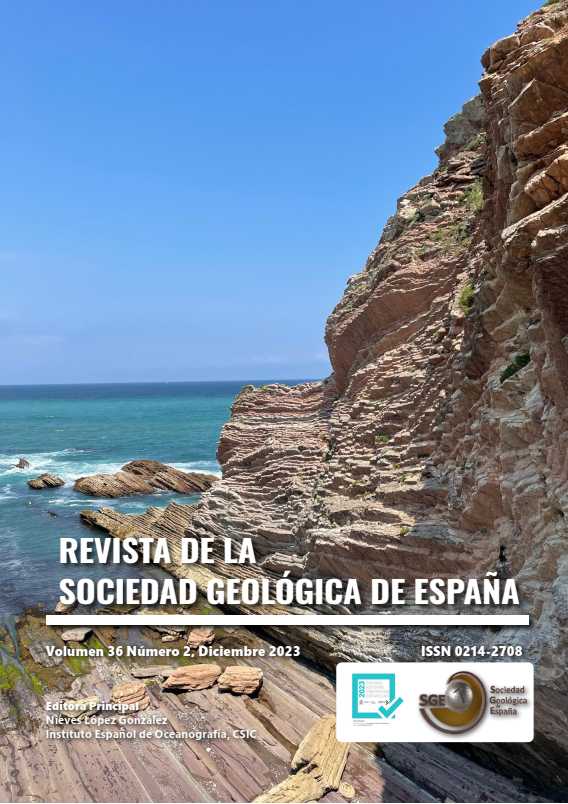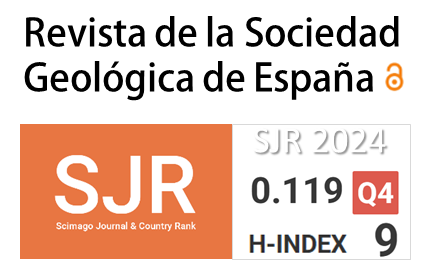Speleogenesis in Miocene reef platforms. The Boca de Jaruco Karst (Mayabeque-Cuba)
DOI:
https://doi.org/10.55407/rsge.101061Keywords:
Karst caves, dissolution-corrosion, tidal influences, water mixing, coastal platforms, cave fillsAbstract
Between 2019 and 2020, several work campaigns were carried out in the Boca de Jaruco karst, which resulted in new advances in the knowledge of the genesis of these cavities. The Boca de Jaruco karst has a surface area of only 3 km2 where 18 cavities of speleological interest are known. It is a coastal platform formed by reef carbonates in which three formations of ages ranging from the Lower Miocene to the Pleistocene can be distinguished. The area studied extends along the right bank of the Jaruco River to its mouth. In six of the caves, a detailed topography including 3D digital models is available. In the largest cave, known as Cinco Cuevas, we studied the existing sedimentary fills, collapse fills, speleothems and the morphologies of condensation-corrosion observed on its walls. In addition, drip water and groundwater samples were taken in the three cavities that reach the water table and in other parts of the aquifer. Pressure, temperature and electrical conductivity sensors were also installed in these flooded areas to study the degree of connection of the caves with the sea. The results showed the influence of tides and the presence of water mixtures of different salinity in the water stored in the aquifer. A speleogenetic model is proposed that would begin in the Pliocene or Lower Pleistocene influenced by tectonic and eustatic movements where salt-fresh water mixtures would have played a fundamental role.
References
Acevedo-González, M., 1967. Estudio espeleológico de la cueva el Vaho o Bao. Boca de Jaruco. Habana. Rev. Serie Ciencias Biológicas. Fasc. 1. Vol. 1, n° 5. J.
Appelo, C.A.J., Postma, D., 1993. Geochemistry, Groundwater and Pollution, Balkema, Rotterdam, 536 p.
Audra, P., Hoblea, F., Bigot, J.Y., Nobecort, J.C. 2007. The Role of Condensation Corrosion in Thermal Speleogenesis. Study of a Hypogenic Sulfidic cCve in Aix-les-Bains, France. Acta carsologica, 36(2): 185-194. https://doi.org/10.3986/ac.v36i2.186
Back, W., Hanshaw, B.B., Herman, J.S., Van Driel, J.N., 1986. Differential dissolution of a Pleistocene reef in the ground-water mixing zone of coastal Yucatan, Mexico. Geology, 14(2): 137-140. https://doi.org/10.1130/0091-7613(1986)14<137:DDOAPR>2.0.CO;2
Bogli, A., 1964. Mischungskorrosion-Ein Beitrag Zum Verkarstungsproblem: Erdkunde, 18: 83-92. https://doi.org/10.3112/erdkunde.1964.02.02
Boop, L.M., Wynn, J.G., Thompson, G., Fornos, J.J., Onac, B.P., 2017. Interactions between surface conditions, the Mediterranean Sea, and cave climate within two littoral caves in Mallorca: implications for the formation of phreatic overgrowths on speleothems. Journal of Cave & Karst Studies, 79(1): 59-72. https://doi.org/10.4311/2016ES0114
Chappell, J., 2002. Sea level changes forced ice breakouts in the Last Glacial cycle: new results from coral terraces. Quaternary Science Reviews, 21: 1229-1240. https://doi.org/10.1016/S0277-3791(01)00141-X
Craig, H., 1961. Isotopic variations in meteoric waters. Science, 133: 1702-1703. https://doi.org/10.1126/science.133.3465.1702
Craig, H., Gordon L.I., 1965. Deuterium and Oxygen-18 variations in the ocean and the marine atmosphere. In: Tangiorgi, E. (ed): Stable isotopes in oceanographic studies and paleotemperatures - Vienna: IAEA, 130.
De Albear, J.F., Iturralde Vinent, M., 1978. Estratigrafía de la provincia de La Habana. En: Contribución a la geología de las provincias de La Habana y ciudad de La Habana. Instituto de Geología y Paleontología. Academia de Ciencias de Cuba. 12-54.
De Waele, J., D'Angeli, I.M., Bontognali, T., Tuccimei, P., Scholz, D., Jochum, K.P., Columbu, A., Bernasconi, S.M., Fornos, J.J., Grau González, E.R., Tisato, N., 2018. Speleothems in a north Cuban cave register sea-level changes and Pleistocene uplift rates. Earth Surface Processes and Landforms, 43(11): 2313-2326. https://doi.org/10.1002/esp.4393
Ducloz C., 1963. Etude géomorphologique de la région de Matanzas, Cuba. Archives des Sciences Génève, 16: 351-422.
Fagundo, J.R., 1996. Química del Agua Kárstica. En: Hidroquímica del Karst. J.R. Fagundo, J.E. Rodríguez, J.J. Valdés, Universidad de Granada, 13-124.
Fagundo, J.R., González, P., Jiménez, S., Benítez, G., Ferrera, V., Ramírez, J., González, A., Romero, E., Orihuela, D., Ramírez, J., Suárez, M., 1999. Metodología para la caracterización geoquímica de los acuíferos cársicos costeros II. Identificación de los procesos de mezcla y modificación de las facies hidroquímicas. En: Contribución a la Educación y la Protección Ambiental. Ed. ISCTN (CITMA), 182-191.
Fratesi, B., 2013. Hydrology and geochemistry of the freshwater lens in coastal karst. In: Coastal karst landforms, 59-75. Dordrecht: Springer Netherlands. https://doi.org/10.1007/978-94-007-5016-6_3
Gonfiantini, R., Simonot, M., 1987. Isotopic investigations of groundwater in the cul-de-Sac Plain, Haiti. Proc. Symp. Isotope Tech. in Water Resources Development, Vienna: IAEA, 506.
Iturralde-Vinent, M., 1985. Algunos aspectos geomorfológicos del territorio de las provincias de La Habana. En: Contribución a la geología de las provincias de La Habana y ciudad de La Habana. Instituto de Geología y Paleontología. Academia de Ciencias de Cuba, 5-11.
Lundberg, J., 2013. Microsculpturing of solutional rocky landforms. In: Shroder, J. (Ed.-inchief) and Frumkin, A. (Vol. Ed.), Treatise in Geomorphology, 6: 121-138. Elsevier, Academic Press, Amsterdam. https://doi.org/10.1016/B978-0-12-374739-6.00129-9
Magaz, A.R., 2017. Geomorfología de Cuba. Amazon Books, Kindley editions. 377 p.
Magaz, A.R., 2021. Morfoestructuras. Las vias principales para su identificación y caracterización. Cuba Geográfica. Cuadernos de Geomorfología de Cuba: 1-32.
Mylroie, J.E., 2013. Coastal karst development in carbonate rocks. In: Coastal karst landforms, 77-109. Dordrecht: Springer Netherlands. https://doi.org/10.1007/978-94-007-5016-6_4
Mylroie, J.E., Carew, J.L., 1990. The flank margin model for dissolution cave development in carbonate platforms. Earth surface processes and landforms, 15(5): 413-424. https://doi.org/10.1002/esp.3290150505
Molerio-León, L.F., 1992. Composición Química e Isotópica de las Aguas de Lluvia de Cuba. II Cong. Espel. Latinoamérica y el Caribe, Viñales, Pinar del Río, Cuba, 20-21.
Molerio-León, L.F., 2013. Evidencias de carsificación y cavernamiento mixto epi-hipogenético en la Cobertura Neoautóctona de la Franja de Crudos Pesados del Norte de La Habana-Matanzas. Mapping Latino, 2.
Molerio-León, L.F., 2018. Cronoestratigrafía relativa de eventos paleosísmicos en el tercio inferior del Río Jaruco, Cuba occidental. Gota a Gota, 15: 93-96.
Muhs, D.R., Schweig, E.S., Simmons, K.R., Halley, R.B., 2017. Late Quaternary uplift along the North America-Caribbean plate boundary: Evidence from the sea level record of Guantanamo Bay, Cuba. Quaternary Science Reviews, 178: 54-76. https://doi.org/10.1016/j.quascirev.2017.10.024
Otero-Collazo, V., Zaldivar-Chateloin, B., 1986. Notas preliminares geoespeleológicas de Boca de Jaruco. 2da Jornada Científica Provincial. Ciudad de La Habana.
Otero-Collazo, V., González-Ramón, A., Molerio-León, L. Chaves-Bonora, O., Alonso-Martínez, M., 2021. Sobre la espeleogénesis de las cavidades de Boca de Jaruco. Mayabeque-Cuba. Primeros resultados de las campañas de 2019-2020. Boletín de la Sociedad Española de Espeleología y Ciencias del Karst, 16: 6-15.
Palmer, A., 1991. Origin and morphology of limestone caves. Geol Soc. Am. Bulletin, 103(1): 1-21. https://doi.org/10.1130/0016-7606(1991)103<0001:OAMOLC>2.3.CO;2
Palmer, A.N., 2007. Cave geology. Cave Books, Dayton.
Palmer, R., Williams, D., 1984. Cave development under Andros Island, Bahamas: Cave Science, 11(1): 50-52.
Rodés, L., 1925. Los cambios de nivel en las cuevas del Drach (Manacor, Mallorca) y su oscilación rítmica de 40 minutos. Memorias de la Academia de Ciencias y Artes de Barcelona, 19 (7): 207-221.
Sarbu, S.M., Lascu, C., 1997. Condensation corrosion in Movile cave, Romania. Journal of Cave and Karst Studies, 59 (3): 99-102, Huntsville.
Downloads
Published
How to Cite
Issue
Section
License
Copyright (c) 2023 Antonio González Ramón

This work is licensed under a Creative Commons Attribution-NonCommercial-ShareAlike 4.0 International License.

The Author retains the copyright and grants to the Geological Society of Spain the right of first publication and grants non-exclusive distribution rights for this article for the duration of the literary property under Spanish law, in all current or future media, being the work available simultaneously to its publication under the Creative Commons CC BY-NC-SA 4.0 license, which allows copying and transforming the work, but taking into account that the distribution of the transformed work must be under the same license and never for commercial purposes, while acknowledging authorship and original publication in the Revista de la Sociedad Geológica de España.










